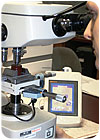
Atrona Laboratories is housed in a 10,500 square-foot, climate-controlled facility. The lab is accredited internationally to ISO/IEC 17025 and ANSI/NCSL Z540 as well as compliant with ISO 9001: 2000. Atrona offers a full line of testing services from failure analysis, hardness testing and scanning electron microscopy, to mechanical testing, reverse engineering and even expert witness services.
At the contracted services laboratory, Odeh, president and principal metallurgist, and a staff of eight metallurgists, engineers and technicians serve tier-one automotive, aerospace and military manufacturers, and other metal-cutters and mills and foundries, as well as governmental and educational institutions.
"Projects come in from around the world," explains Odeh. "Domestic manufacturers specifying overseas production of products destined to be sold in the United States generally require metallurgical testing to U.S. standards. That's how test articles come to us from Europe, India, China and Brazil."
Hardness testing can be performed alone, or it can be part of failure analysis or other testing routines such as heat-treat certifications, making it the test most frequently performed by Atrona.
Although it does not give a direct measurement of specific properties beyond resistance to plastic deformation by penetration, hardness testing is a good analog for resistance to bending and abrasion, as well as of material strength and toughness. Hardness testing also is relatively quick, easy and economical to perform.
The high volume of hardness testing performed, along with the fact that immediate turnaround of hardness is often required by walk-in clients, has provided the impetus for Atrona to focus on achieving the highest possible productivity in performance of these tests. Describing the challenge, Odeh explains, "Even though we are a lab, and always work against prescribed protocol, we are also in the real world. When a customer comes in and asks, ‘I've got a catastrophic failure on the line, what happened?' or says, ‘This part has just been recalled!' they're looking for answers right now, often the same day." Odeh says, "It is often hardness testing that provides the needed answers quickly."

Productivity Strategy
In the firm's early days, Odeh conducted hardness testing himself, but demand for the testing outstripped time available. "I had to develop an institutional hardness testing capability," Odeh explains. "We established a hardness training routine, the effectiveness of which is verified by certification. That, together with procurement of the right test equipment, ensured the needed productivity, whether it was me or staff specialists performing the tests."Every member of Atrona's staff is certified to Level 2 Hardness Testing, which enables verification from one operator to the next.
Instruments are another area where Atrona achieves testing productivity gains. Odeh emphasizes, "The design of lab equipment greatly impacts output." For example, a domestic off-highway manufacturer contacted Atrona for hardness testing on 30 prototype gears received from China. The 8-inch outer diameter and 3-inch bore of each gear required nondestructive testing so the customer could begin immediate in-house mechanical functionality testing. Odeh continues, "The gears could not be sectioned, but that didn't matter since we were using a Mitutoyo HR-500 bench model Rockwell/Brinell instrument to test for Rockwell C-Scale. The HR-500 has a specially designed gooseneck enabling it to access the bore ID directly, eliminating the need for sectioning. And it was fast; we tested all 30 gears in a few hours."
Instrument design affects hardness testing performance, as Odeh relates, "For microhardness testing, we use a Mitutoyo HM-122 microhardness testing machine. Operation is simple. It uses an LCD touchscreen to select indentation value, type of indenter, indentation force and tolerance judgment. And, the HM-122 prints out measurements in formats ready to provide to the client. That means we no longer have to hand transcribe results into a written report. That's faster, and opportunities to miscopy something, or to forget to write something down are eliminated, as is the chance to misidentify which samples go with what results."
Odeh explains the process that resulted in the Mitutoyo instrument purchase: "We conducted a survey to find the most accurate benchtop hardness testers that would also be easy to train on. We looked at the major makers to assess their hardware, software and product support. The HR-500 and HM-122 fit the bill so we asked our Mitutoyo distributor for a demo. These machines proved real intuitive to use and it wasn't long before everyone conducting hardness testing was proficient on them. The Mitutoyo testers have been in constant use for four years and have proven bulletproof."
Mitutoyo America Corp.
(630) 820-9666
www.mitutoyo.com
Benefits
• The HM-122 prints out measurements in formats ready to provide to the client, so Atrona no longer has to transcribe results by hand into a written report.• This method saves time and helps eliminate human error.
• The HM-122 microhardness testing machine uses an LCD touchscreen to select indentation value, type of indenter, indentation force and tolerance judgment.